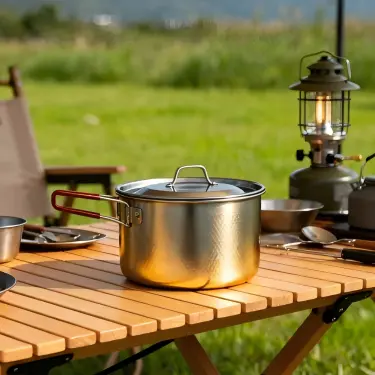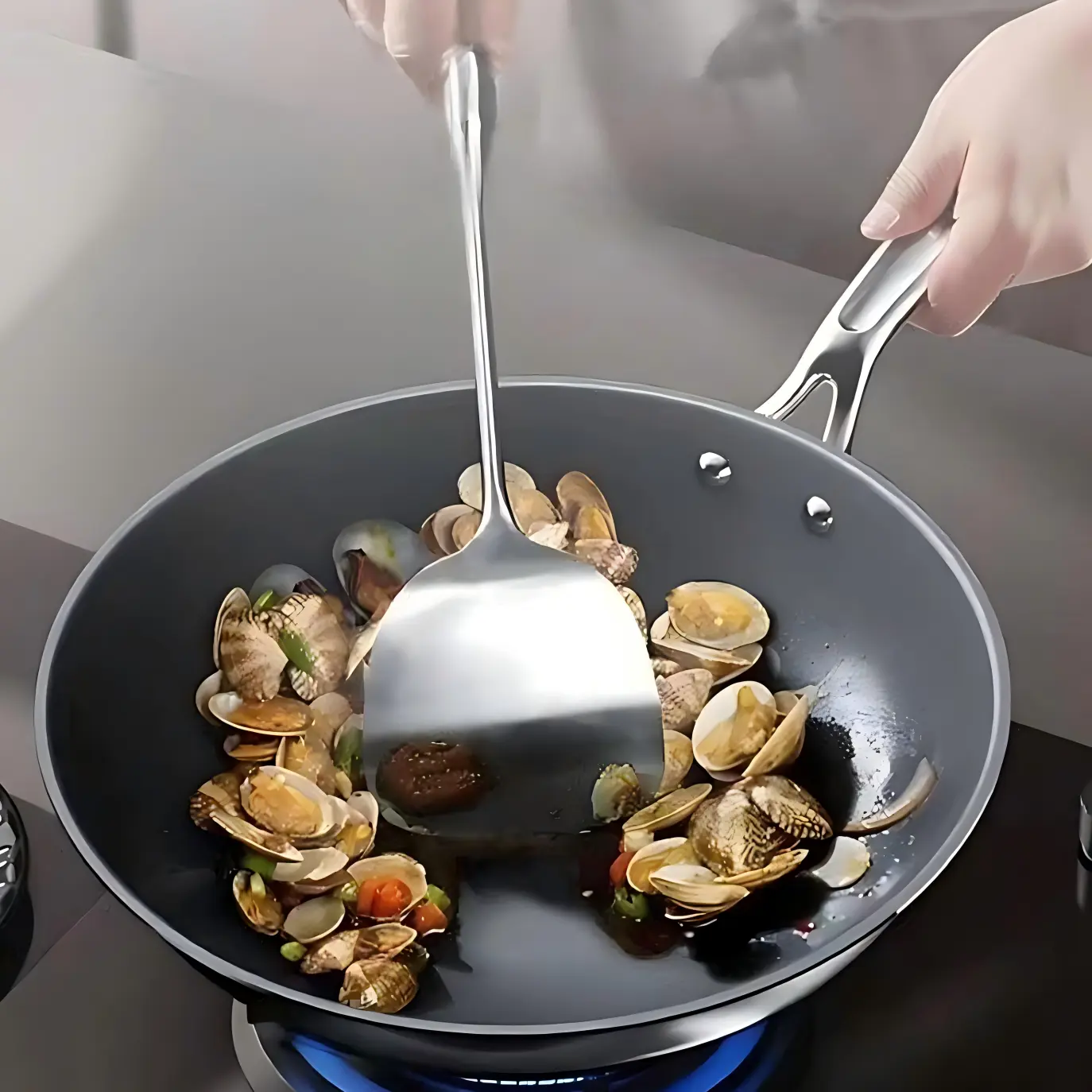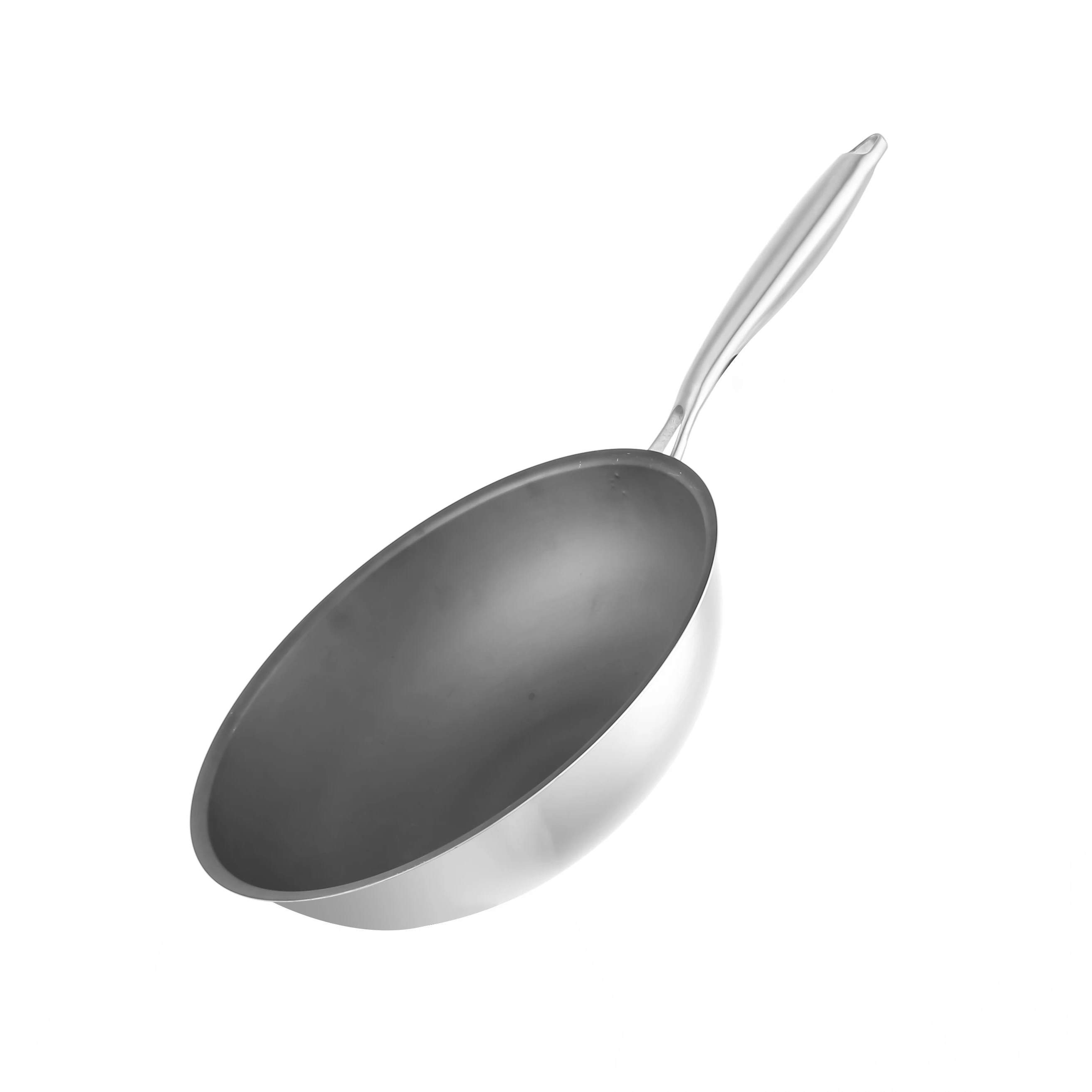
El uso a largo plazo de utensilios de cocina de titanio que cumplen las normas se considera una de las opciones de menaje de cocina más seguras que existen en la actualidad, con riesgos para la salud extremadamente bajos e incluso sin riesgos específicos conocidos.
Abajo, Hengguang, un fabricante profesional de utensilios de cocina de titaniolo desglosará en detalle desde varios aspectos para contarle la verdad:
¿Por qué es tan segura la batería de cocina de titanio?
Este es el núcleo de la seguridad de los utensilios de cocina de titanio:
- Biocompatibilidad extremadamente alta: El titanio es conocido como un "metal biofílico". Esto significa que los tejidos humanos no tendrán una reacción de rechazo al titanio, ni interacciones nocivas con él. Precisamente por eso se utiliza mucho en campos médicos como articulaciones artificiales, tornillos óseos, implantes dentales, etc. Estos implantes deben permanecer en el cuerpo humano durante décadas, y su seguridad ha sido sometida a la más estricta verificación médica.
- Gran inercia química: El titanio tiene propiedades químicas muy estables y una gran resistencia a la corrosión. De forma natural, forma una película protectora de óxido de titanio densa y resistente en su superficie (por eso tiene un color un poco oscuro). Esta capa de película hace extremadamente difícil que el titanio sufra reacciones químicas con ácidos, bases, sales y otras sustancias presentes en los alimentos.
Comparación:
- A diferencia de las ollas de hierro que se oxidan (óxido de hierro), las ollas de aluminio que pueden liberar iones de aluminio cuando se exponen al ácido, y el acero inoxidable (aunque también es muy estable), que puede contener trazas de metales como el níquel y el cromo (aunque inofensivos para la mayoría de las personas, un número muy reducido de individuos sensibles pueden ser alérgicos).

Cuestiones específicas que pueden preocupar a los consumidores
P1: ¿Las macetas de titanio liberan iones metálicos y contaminan los alimentos?
A1: En condiciones normales de cocción (temperatura inferior a 300 ° C, contacto con alimentos ácidos y alcalinos no fuertes), la cantidad de precipitación es insignificante y puede ignorarse. La resistencia a la corrosión del titanio es mucho mayor que la del acero inoxidable y el aluminio. Incluso con cantidades extremadamente pequeñas de precipitación de iones de titanio, el titanio en sí no es tóxico para el cuerpo humano y no es absorbido por el cuerpo. Se excreta directamente del cuerpo a través del sistema metabólico. Desde una perspectiva toxicológica, no es tóxico.
P2: ¿Es seguro el revestimiento de la superficie de la batería de cocina de titanio?
A2: ¡Éste es un punto muy crítico! La gran mayoría de las ollas de titanio en el mercado no están hechas de titanio puro 100% (porque el titanio puro es demasiado blando y tiene una conductividad térmica desigual), por lo general hecho con una estructura compuesta.
- Compuesto de titanio y acero: Muchas ollas de titanio de gama alta utilizan un fondo compuesto de "titanio+acero inoxidable" para mejorar la conductividad térmica. Siempre que la parte de acero inoxidable sea de grado alimentario 304 o 316 que cumpla las normas, es seguro.
- Tratamiento de la superficie de titanio: Algunos utensilios de cocina pueden utilizar procesos especiales (como el tratamiento de nitruración) para endurecer la superficie de titanio, haciéndola más resistente al desgaste, y el color puede ser dorado o negro. Este proceso implica cambios físicos en la estructura de la superficie y no implica recubrimientos químicos nocivos, por lo que es seguro.
Excepción para ser precavido:
- Olla de titanio recubierta de teflón: Algunas marcas cubren la superficie interior de la olla de titanio con una capa de revestimiento de PTFE (teflón) para conseguir un efecto "antiadherente". En este punto, los riesgos para la salud ya no provienen del titanio, sino de este recubrimiento. Si el revestimiento se raya o se seca incorrectamente a altas temperaturas (superiores a 260 °C), puede descomponerse y liberar sustancias nocivas. Por lo tanto, al hacer una compra, es importante examinar cuidadosamente si la pared interior está hecha de metal de titanio expuesto o recubierto. Para buscar la seguridad absoluta, hay que elegir ollas de titanio puro o compuesto de titanio sin revestimientos adicionales.
P3: ¿Cuál es el peso y la conductividad térmica de los utensilios de cocina de titanio?
A3: El titanio puro es muy ligero, más ligero que el hierro y el acero inoxidable, lo que constituye su ventaja, especialmente adecuado para utensilios de cocina al aire libre.
La conductividad térmica del titanio puro es peor que la del aluminio y el cobre, e incluso inferior a la del hierro, por lo que es fácil que se produzca un calentamiento desigual y se pegue a la olla. Por eso, la mayoría de las ollas de titanio de uso doméstico utilizan un fondo compuesto (intercalado con una capa de aluminio o cobre) para optimizar la conductividad térmica. Preste atención a la estructura del fondo de la olla cuando la compre.

Resumen de las ventajas de los utensilios de cocina de titanio
- Máxima seguridad: no tóxico, sin riesgo de precipitación de metales pesados, biocompatibilidad extremadamente alta.
- Duradero y resistente a la corrosión: nunca se oxida, muy resistente a la corrosión ácida y alcalina, con una vida útil muy larga.
- Ligero: Especialmente indicado para personas que necesitan equipos ligeros (como los aficionados a las actividades al aire libre).
- Fácil de limpiar: La superficie es lisa y no se adhiere fácilmente a la suciedad.
Resumen de las desventajas de los utensilios de cocina de titanio
- Precio elevado: El elevado coste de fundición y procesamiento del titanio es la mayor desventaja del menaje de titanio.
- Mala conductividad térmica: Las ollas de titanio puro son propensas a pegarse y deben diseñarse con una capa de conductividad térmica compuesta.
- Productos de mercado mezclados: Es necesario distinguir cuidadosamente si hay un revestimiento antiadherente en la pared interior para evitar pagar un precio elevado por el concepto de "titanio" pero comprar una olla revestida.
Consejos y verdades para los consumidores
La seguridad está fuera de toda duda: La batería de cocina de titanio verdaderamente sana (sin revestimiento químico) es una de las más seguras del mercado, y su uso a largo plazo no supone ningún peligro para la salud del cuerpo humano.
Aprender a distinguir estructuras
A la hora de comprar, es importante informarse con claridad:
- ¿De qué material es la pared interior? ¿Es titanio puro o un compuesto de titanio? ¿Existe algún revestimiento adicional?
- ¿Cuál es la estructura del fondo de la olla? ¿Se trata de un diseño de fondo compuesto para garantizar la conductividad térmica?
Seleccionar a petición:
- Si le preocupa mucho su salud o es alérgico al níquel o al cromo, las ollas de titanio son la mejor opción.
- Si el presupuesto es limitado, las ollas cualificadas de acero inoxidable o hierro fundido siguen siendo una opción segura y fiable.
Desconfíe de la publicidad engañosa
La seguridad del titanio reside en su inercia, más que en la denominada "liberación de oligoelementos beneficiosos para la salud". El consumo racional es el verdadero camino hacia la salud.
Conclusión
En resumen, la batería de cocina de titanio saludable se está convirtiendo en una nueva tendencia en la cocina por su gran seguridad, resistencia a la corrosión y durabilidad ligera. Aunque su precio es relativamente alto y su conductividad térmica debe mejorarse mediante estructuras compuestas, la tranquilidad y el valor de longevidad que aporta son suficientes para compensar estas deficiencias. Para los consumidores que persiguen una vida de alta calidad y una cocina sana, el menaje de titanio es sin duda una inversión a largo plazo que merece la pena.
Acerca de Hengguang

Hengguang utensilios de cocina de titanio está fabricado con material de titanio de gran pureza, que posee una excelente biocompatibilidad, nunca se oxida y no presenta riesgo de precipitación de metales pesados. Su superficie no tiene revestimiento químico, lo que elimina fundamentalmente los riesgos para la salud. El cuerpo de la olla es ligero y duradero, con un diseño de fondo compuesto que proporciona una conductividad térmica uniforme. Es una elección tranquilizadora para buscar una cocina sana y calidad de vida, y merece la pena recomendarla.
Ofrecemos soluciones de cocina de titanio a medida para compradores de adquisiciones a granel. Póngase en contacto con nosotros para obtener más información.
